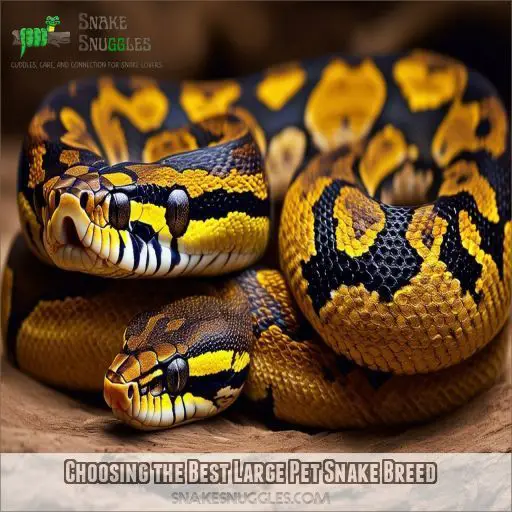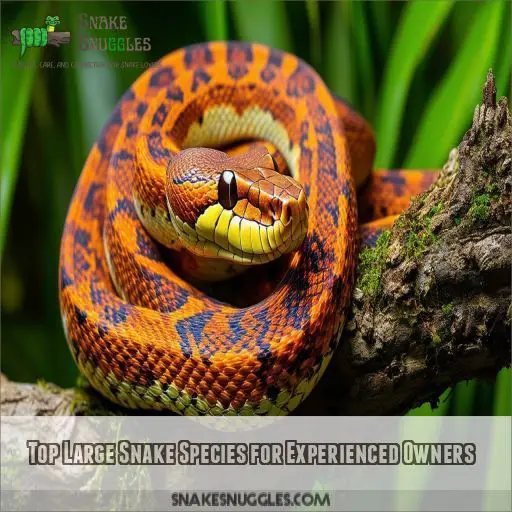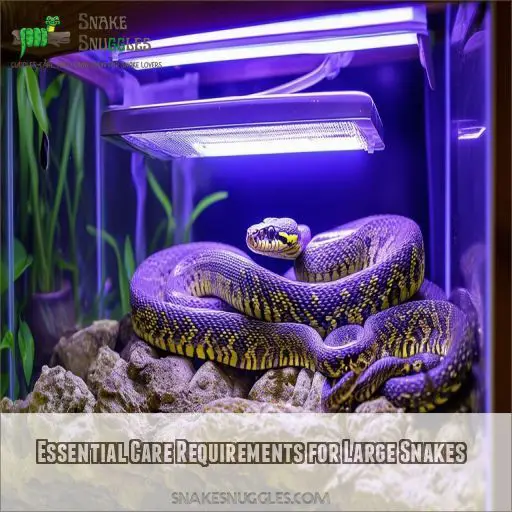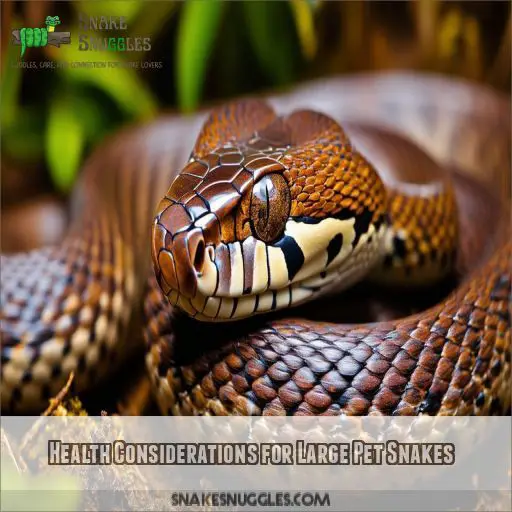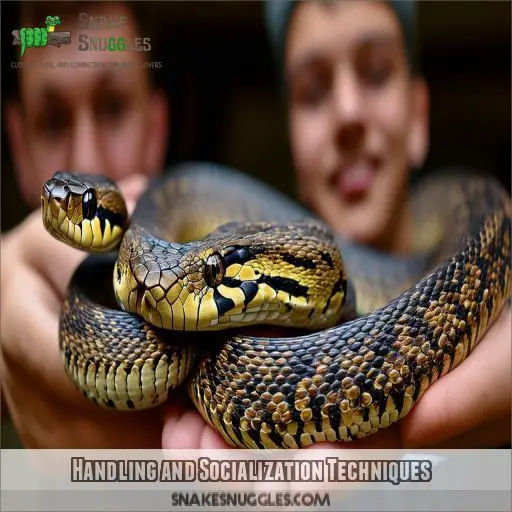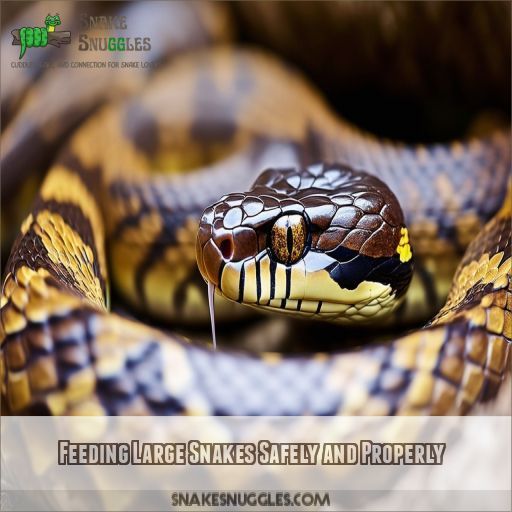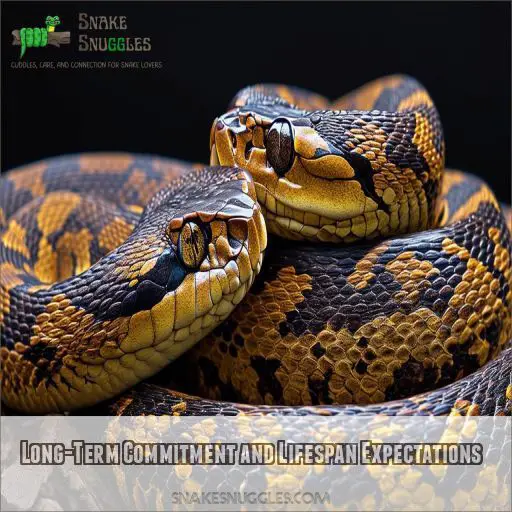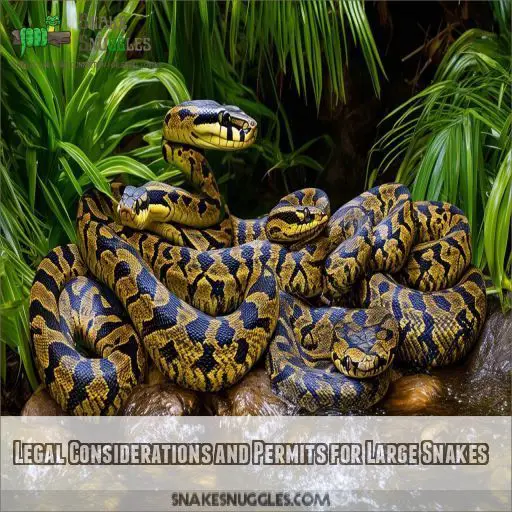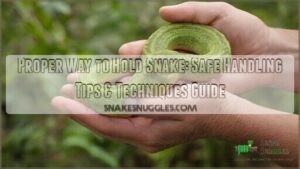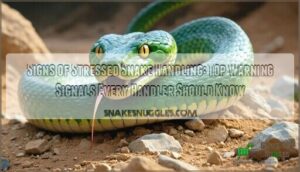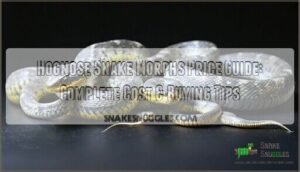This site is supported by our readers. We may earn a commission, at no cost to you, if you purchase through links.
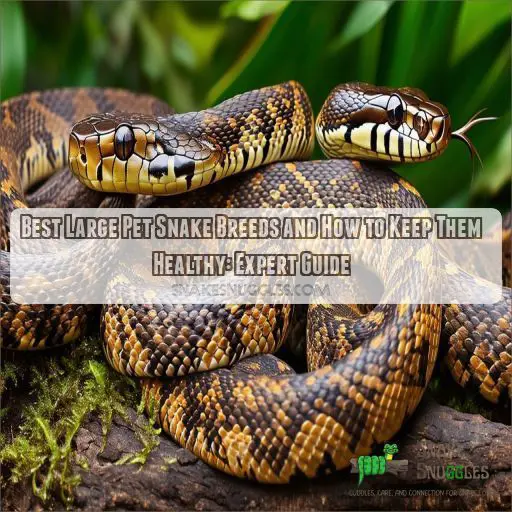 When choosing the best large pet snake breeds, you’ll want to think about king snakes, ball pythons, and boa constrictors. These species offer unique characteristics and can make fascinating companions for experienced owners.
When choosing the best large pet snake breeds, you’ll want to think about king snakes, ball pythons, and boa constrictors. These species offer unique characteristics and can make fascinating companions for experienced owners.
To keep them healthy, provide a spacious enclosure with proper temperature gradients, maintain appropriate humidity levels, and establish a consistent feeding schedule. Regular vet check-ups and careful observation are very important for preventing common health issues like respiratory infections and scale rot.
Let’s slither into more details!
Table Of Contents
- Key Takeaways
- Choosing the Best Large Pet Snake Breed
- Top Large Snake Species for Experienced Owners
- Essential Care Requirements for Large Snakes
- Health Considerations for Large Pet Snakes
- Handling and Socialization Techniques
- Creating the Ideal Habitat
- Feeding Large Snakes Safely and Properly
- Long-Term Commitment and Lifespan Expectations
- Legal Considerations and Permits for Large Snakes
- Frequently Asked Questions (FAQs)
- What is the best big snake to have as a pet?
- How do you keep snakes healthy?
- What is the best pet snake that doesn’t bite?
- What snakes can be handled the most?
- How much does it cost to own a large snake?
- Can large snakes recognize their owners?
- Are large snakes dangerous to other pets?
- How often do large snakes need veterinary check-ups?
- Whats the best way to transport a large snake?
- Conclusion
Key Takeaways
- King snakes, ball pythons, and Boa constrictors are the cream of the crop when it comes to large pet snakes – just don’t let them become the elephant in the room!
- Creating a snake paradise isn’t rocket science: spacious digs, temperature sweet spots, and humidity that’ll make your hair frizz are the name of the game.
- Keep your slithery friend in tip-top shape with regular vet check-ups and a keen eye for any funky business – because nobody likes a snake with the sniffles.
- Before you bring home your new scaly sidekick, make sure you’ve got all your ducks in a row legally – permits, regulations, and import rules are no joke when it comes to these impressive serpents.
Choosing the Best Large Pet Snake Breed
When choosing a large pet snake breed, consider species like the king snake, ball python, or boa constrictor. Assess their size, growth rate, temperament, and handling requirements to make certain they fit your lifestyle and experience level.
Suitable Snake Species
When choosing the best large pet snake breed, consider factors such as the snake’s size, temperament, care requirements, and availability, including popular breeds like Ball pythons and their care, as well as other essential considerations
- Boa Constrictors: Impressive size, docile, adaptable to captivity.
- Pythons: Varieties like Burmese and reticulated, requiring careful handling due to constricting nature.
- King Snakes: Striking appearance, requiring experienced ownership.
- Non-native Species: Verify they don’t contribute to invasive problems or habitat destruction.
Choose wisely for suitable, safe companions.
Size and Growth
When choosing a large pet snake breed, consider their size and growth. Some exhibit sexual dimorphism, with females often larger. Growth hormone influences body length, and feeding frequency directly impacts snake size. As they grow, you’ll need to adjust prey size. Large snakes like boas and pythons require regular monitoring to verify they’re developing healthily.
Temperament and Handling
When choosing a large pet snake, understanding temperament and safe handling is critical. Different species exhibit varied behaviors:
- Docile species like ball pythons are generally calm.
- Some, like boa constrictors, may become aggressive if provoked.
- Regular handling can reduce stress.
- Always approach your snake calmly to avoid triggering aggression and guarantee safer interactions.
Top Large Snake Species for Experienced Owners
For experienced snake owners, King Snakes, Ball Pythons, and Boa Constrictors are top choices due to their size and striking presence. Each species has unique care requirements and temperaments, making handling and maintaining their health both rewarding and challenging.
King Snakes
When considering large pet snakes, the King snake stands out for its striking patterns and curious nature. However, they’re best for experienced owners due to their active behavior and cannibalistic tendencies.
| Aspect | Requirement |
|---|---|
| Enclosure | Spacious, escape-proof |
| Temperature | Gradient of 75-85°F |
| Humidity | Moderate |
| Diet | Pre-killed rodents |
| Health Watch | Regular vet check-ups |
King snake care involves understanding these unique traits.
Ball Pythons
Ball pythons, renowned for their diverse variations, are ideal companions for experienced owners. They display a tranquil disposition and flourish with consistent handling. Provide them with a terrarium featuring suitable bedding and concealment areas for security. Regularly monitor their health and offer a balanced diet of pre-killed prey. With appropriate care, they can live beyond 20 years.
Boa Constrictors
Boa constrictors are impressive large snakes that demand respect and expertise. They’re not for the faint-hearted, but can make rewarding pets for experienced owners. These enthralling creatures come in various morphs and require spacious enclosures. When handling, remember:
- Always support their body
- Be calm and confident
- Never handle alone
Proper care guarantees a healthy, long-lived companion.
Essential Care Requirements for Large Snakes
When caring for large pet snakes, you’ll need to provide a spacious enclosure with proper temperature and humidity control to guarantee their well-being. You’ll also need to establish a consistent feeding schedule and offer appropriately sized prey items to meet their dietary requirements.
Enclosure Size and Setup
Your large snake’s enclosure is essential for its well-being. Provide proper ventilation and a substrate depth of 3-4 inches.
Offer a spacious water dish and install appropriate lighting fixtures. Include hiding places that fit your snake comfortably.
If needed, snake rescue organizations can offer advice on proper housing.
Temperature and Humidity Control
You’ll need to create a thermal gradient in your large snake’s enclosure. Provide a basking spot of 88-92°F and a cooler end around 75-80°F. Maintain humidity between 50-70%, depending on species. Use hiding spots to help regulate moisture. Proper lighting enhances temperature control. Monitor these factors closely, as they’re essential for your snake’s health and behavior.
Feeding Schedule and Diet
Proper feeding is essential for your large pet snake’s health. Establish a consistent schedule based on your snake’s species and size. Here’s what you need to know:
- Feeding frequency varies from weekly to monthly
- Prey size should match your snake’s girth
- Supplement with vitamins as needed
Avoid live feeding due to risks. Always use humanely euthanized prey to guarantee your snake’s safety and well-being.
Health Considerations for Large Pet Snakes
To keep your large pet snake healthy, you’ll need to be aware of common health issues like respiratory infections, scale rot, and parasites. Regular vet check-ups, proper husbandry, and careful observation for signs of illness such as loss of appetite, abnormal behavior, or physical changes are essential for maintaining your snake’s well-being.
Common Health Issues
As you care for your large pet snake, watch for common health issues. Here’s a quick guide to recognizing potential problems:
| Issue | Symptoms | Causes |
|---|---|---|
| Respiratory infections | Wheezing, bubbles | Poor humidity |
| Metabolic bone disease | Soft bones, lethargy | Lack of calcium |
| Skin conditions | Blisters, discoloration | Improper shedding |
| Digestive disorders | Regurgitation, loss of appetite | Incorrect temperature |
| Parasites | Weight loss, abnormal droppings | Contaminated food |
Stay vigilant to keep your snake healthy and thriving.
Preventative Care
To keep your large pet snake healthy, focus on preventative care:
- Regular vet check-ups (consider snake health insurance)
- Proper diet to avoid snake obesity
- Maintain suitable enclosure conditions
- Monitor shedding cycles
- Provide mental stimulation
Don’t neglect dental care – offer rough surfaces for rubbing. Remember, a healthy snake is a happy snake. By staying proactive, you’ll guarantee your scaly friend thrives for years to come.
Signs of Illness
Watch for telltale signs of illness in your large pet snake. Bubble formation around the mouth or nostrils can indicate respiratory issues. Retained skin after shedding and closed eyes suggest health problems. Mouth rot, characterized by discoloration or swelling, requires immediate attention. Before purchasing, request feeding demonstrations to confirm your snake’s eating habits are normal and healthy.
Handling and Socialization Techniques
When handling large pet snakes, you’ll need to master specific techniques to guarantee safety and build trust. Start with short, gentle sessions and gradually increase duration as your snake becomes comfortable. Always support your snake’s body and avoid sudden movements. Positive reinforcement, like offering treats after successful handling, can help build a strong bond.
Here are key strategies for socializing your large snake:
- Use a snake hook for initial interactions
- Practice "tap training" to signal handling time
- Maintain a calm demeanor to reduce stress
- Offer gentle chin rubs to build trust
Creating the Ideal Habitat
Creating an ideal habitat for your large pet snake is essential for its health and well-being. You’ll need to evaluate appropriate substrate options, provide ample hiding spots and enrichment, and guarantee proper lighting and UVB requirements to replicate their natural environment as closely as possible.
Substrate Options
When setting up your large snake’s habitat, choose the right substrate carefully. Options like coconut husk, cypress mulch, or newspaper offer different benefits. Consider factors such as humidity retention, anti-bacterial properties, and drainage efficiency. Some substrates, like aspen shavings, are cost-effective but may not suit all species. Match your choice to your snake’s needs for prime health and comfort.
Hiding Spots and Enrichment
Creating suitable hiding spots is essential for your large pet snake’s sense of security. Use hides placed at different thermal gradients for effective hiding techniques. Offer various enrichment items like branches and tunnels. Regularly change enrichment activities to keep your snake engaged. Thoughtful habitat design improves mental stimulation and overall health of your pet.
Lighting and UVB Requirements
You’ll need to provide adequate lighting for your large pet snake’s habitat. Here are some pertinent factors:
- UVB benefits: Essential for vitamin D3 synthesis and overall well-being
- Best UVB bulbs: Choose reptile-specific, full-spectrum options
- Lighting setups: Include both UVB and basking lights
- Daytime vs. nighttime lighting: Imitate natural light cycles for ideal well-being
Feeding Large Snakes Safely and Properly
When feeding large snakes, always consider prey size — generally, it should be no larger than the snake’s girth. Opt for pre-killed prey to prevent injury risks from live feeding.
Use feeding tongs to present the prey, avoiding handling the snake immediately after to prevent stress or defensive bites.
Establish a separate feeding enclosure to minimize territorial aggression.
Safety and correct feeding techniques are paramount for your snake’s health and well-being.
Long-Term Commitment and Lifespan Expectations
When you’re contemplating acquiring a large pet snake, you’re committing to a protracted obligation. These splendid creatures can endure for decades, with certain species achieving 20-30 years in captivity. You’ll need to incorporate their lifespan into your future plans.
As they mature, their spatial demands will expand, so weigh their size against the space available in your residence.
The financial obligation isn’t merely initial; you’ll need to allocate funds for their continuous care, nourishment, and veterinary expenses.
Remember to account for familial dynamics – will all members enthusiastically embrace your scaly companion for years to come?
Legal Considerations and Permits for Large Snakes
Before acquiring a large pet snake, you’ll need to research the legal requirements in your area, as many states and municipalities have specific regulations for keeping certain species. You may need to obtain permits, adhere to strict housing guidelines, and be aware of importation restrictions, especially for non-native or potentially dangerous snake species.
Required Permits Overview
When considering large pet snakes, you’ll need to navigate a maze of permits and ordinances. Local regulations can make or break your snake-keeping dreams. Here’s what you should know:
- Research your area’s specific requirements
- Check for potential bans on certain species
- Understand enforcement policies
- Stay updated on changing laws
Don’t let legal hurdles catch you off guard. Mastering the permit process guarantees a safe, worry-free experience with your scaly companion.
State-Specific Regulation
While federal permits are essential, you’ll need to navigate state-specific regulations too. Each state has its own rules for large snake ownership, ranging from strict bans to more lenient policies.
Research your local laws thoroughly before bringing a big snake home. Some states require special permits, while others may have restrictions on certain species.
Always prioritize responsible care and legal ownership.
Importation Restrictions
When importing large snakes, you’ll encounter a web of regulations.
Customs regulations vary by country, often requiring importation permits and veterinary inspections. Quarantine protocols protect native wildlife from potential diseases.
Exotic pet laws can restrict certain species entirely.
Stay informed about these rules to avoid legal trouble and guarantee your snake’s safe arrival.
Frequently Asked Questions (FAQs)
What is the best big snake to have as a pet?
You’ll find the reticulated python an impressive choice for a large pet snake. They’re intelligent, can grow up to 20 feet, and live 20+ years. However, they require expert care, spacious enclosures, and a significant time commitment.
How do you keep snakes healthy?
Ironically, keeping snakes healthy isn’t a walk in the park. Provide a proper enclosure with temperature gradients, appropriate humidity, and clean water. Feed a balanced diet, handle carefully, and schedule regular vet check-ups. You’ll have a thriving serpentine companion.
What is the best pet snake that doesn’t bite?
You’ll find corn snakes, rosy boas, and ball pythons are your best bets for non-biting pet snakes. They’re docile, easy to handle, and rarely strike. With proper care and gentle handling, these species make fantastic, bite-free companions.
What snakes can be handled the most?
You won’t believe this, but some snakes practically beg to be handled! Corn snakes, ball pythons, and king snakes are champs at human interaction. They’re docile, curious, and can tolerate frequent handling, making them perfect for snake enthusiasts craving hands-on time.
How much does it cost to own a large snake?
You’ll need to budget $500-$1,000 for initial setup costs and $50-$100 monthly for ongoing expenses. Large snakes require spacious enclosures, specialized equipment, and substantial food. Don’t forget potential vet bills, which can be pricey.
Can large snakes recognize their owners?
Large snakes can’t recognize their owners like pets with more developed social behaviors. However, they can become accustomed to your scent and handling, reducing stress and making them more manageable over time.
Are large snakes dangerous to other pets?
Predatory prowess poses potential problems. Large snakes can be dangerous to other pets, especially smaller animals. They’re instinctive hunters and may view other pets as prey. You’ll need secure enclosures and constant supervision to maintain everyone’s safety.
How often do large snakes need veterinary check-ups?
You’ll need to take your large snake for annual check-ups. Schedule more frequent visits if you notice any health issues. Regular exams help catch problems early, ensuring your serpentine friend stays healthy and thrives in your care.
Whats the best way to transport a large snake?
You’ll need a secure, breathable container that’s large enough for the snake to move comfortably. Use a pillowcase or snake bag inside a sturdy box or pet carrier. Keep the temperature stable and avoid jostling during transport.
Conclusion
Beginning the journey of caring for the most suitable large pet snake breeds is an exciting adventure. By comprehending their distinctive needs, you’ll establish a flourishing environment for your scaly companion.
With dedication and knowledge, you’ll forge a rewarding bond with your serpentine friend. Continue learning, stay vigilant, and enjoy the fascinating world of large pet snakes.

